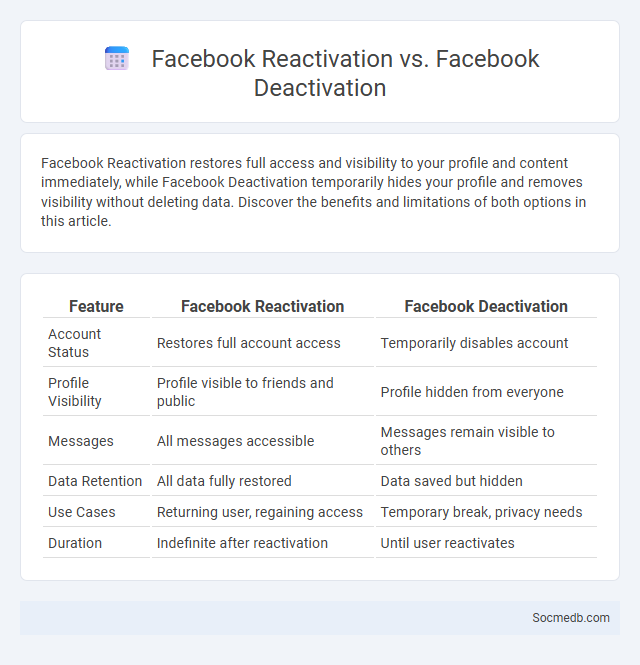
Photo illustration: Facebook Reactivation vs Facebook Deactivation
Facebook Reactivation restores full access and visibility to your profile and content immediately, while Facebook Deactivation temporarily hides your profile and removes visibility without deleting data. Discover the benefits and limitations of both options in this article.
Table of Comparison
| Feature | Facebook Reactivation | Facebook Deactivation |
|---|---|---|
| Account Status | Restores full account access | Temporarily disables account |
| Profile Visibility | Profile visible to friends and public | Profile hidden from everyone |
| Messages | All messages accessible | Messages remain visible to others |
| Data Retention | All data fully restored | Data saved but hidden |
| Use Cases | Returning user, regaining access | Temporary break, privacy needs |
| Duration | Indefinite after reactivation | Until user reactivates |
Understanding Facebook Reactivation
Facebook reactivation involves restoring access to a previously deactivated account, allowing users to reconnect with their social network and retrieve past content such as photos, posts, and messages. The process requires logging in with the original credentials, after which the profile becomes visible again to friends and followers. Reactivation can also revive the user's interaction history, notifications, and account settings, providing a seamless return to the Facebook ecosystem.
What is Facebook Deactivation?
Facebook deactivation is a temporary action allowing users to disable their accounts without permanently deleting their data. When deactivated, profiles become invisible to friends and search engines, but all information, including messages and photos, is saved for future reactivation. This feature provides users with a flexible option to pause social media activity without losing account history or connections.
Key Differences Between Reactivation and Deactivation
Reactivation involves restoring access and functionality to a previously deactivated social media account, allowing users to resume activity and interaction. Deactivation temporarily disables the account, hiding the user profile and content from public view without permanently deleting data. The key difference lies in permanence: deactivation is reversible and aimed at taking a break, while reactivation restores full account privileges after deactivation.
Reasons Users Deactivate Facebook Accounts
Privacy concerns rank highest among reasons users deactivate Facebook accounts, with fears over data misuse and unauthorized tracking. Many users cite mental health impacts, such as anxiety and social comparison, prompting temporary or permanent breaks from the platform. Concerns about misinformation and political content also drive account deactivation, highlighting the need for improved content moderation.
The Process of Facebook Reactivation Explained
Facebook reactivation involves a user logging back into their dormant account, where the platform restores access to their profile, friends list, and previous posts while temporary restrictions from deactivation are lifted. The process requires users to enter their registered email or phone number and password, triggering Facebook's verification system to confirm identity and re-enable account features. Once reactivated, the account resumes normal functionality with all prior data intact, including photos, messages, and group memberships.
Privacy and Security Implications
Social media platforms collect vast amounts of personal data, raising significant privacy concerns related to unauthorized data access and misuse. Users face risks such as identity theft, surveillance, data breaches, and targeted advertising driven by intricate algorithms. Implementing robust security measures like end-to-end encryption, two-factor authentication, and regular privacy audits is crucial to safeguard user information and maintain trust.
Data Retention During Deactivation and Reactivation
Social media platforms retain user data during account deactivation to enable seamless reactivation and restoration of content and connections. Data retention policies typically include preservation of profile information, posts, messages, and friends lists, ensuring user continuity upon returning. Compliance with privacy regulations such as GDPR mandates transparent communication on data handling and retention durations during inactive periods.
Impact on Friends and Social Interactions
Social media transforms how you maintain friendships by enabling constant communication and sharing through platforms like Facebook and Instagram. It reshapes social interactions by expanding your network beyond physical boundaries, allowing connections with diverse communities globally. However, excessive use may lead to superficial relationships, impacting the depth and quality of real-life social bonds.
Common Issues with Facebook Reactivation
Common issues with Facebook reactivation often include account verification challenges, such as difficulties confirming your identity through security questions or uploaded documents. Users frequently encounter temporary suspensions or restrictions that complicate regaining access to their profiles. Resolving these problems requires following Facebook's specific guidelines to ensure your account meets their safety and authenticity standards.
Tips for Managing Your Facebook Account Status
Regularly update your Facebook account status to keep your audience engaged and reflect your current interests or activities. Use clear, concise language and relevant hashtags to increase visibility and reach on the platform. Monitor comments and interactions to maintain a positive online presence and promptly address any feedback or issues.
 socmedb.com
socmedb.com